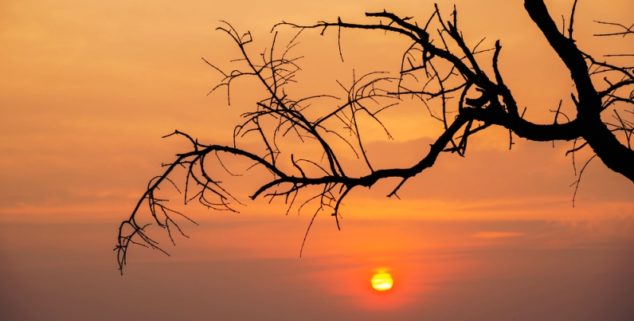News
California’s drought, relentless and inexorable, takes its toll
 A drought-stricken tree at sunset. (Photo: PG_Traveler, via Shutterstock)
A drought-stricken tree at sunset. (Photo: PG_Traveler, via Shutterstock)With the rainy season come and gone, drought’s withered hand remained firmly fixed on California this month, as it has been, with few exceptions, for the last decade.
Woes pile up. Rain didn’t save us, the snowpack is all but gone, the Coastal Commission says no desalinating sea water, and urban-interface fires have already begun.
It’s almost summer in the Golden State.
The so-called wet season has been record-breakingly dry. And snow in the Sierras, a traditional dry-weather water supply, has little to offer this year.
“I would make the case that it’s one long drought going back to 2012.” — Jeannine Jones
“At this time, it’s something like 20 percent of average, but that is essentially meaningless, because most of it is melted and is already in the reservoirs,” said Jeanine Jones, interstate resources manager at the Department of Water Resources. “This is May, the rainy season is ended and we have the supplies we’re going to get.”
Jones discusses the coming summer with seriousness, but not alarm. Among the 150 or so reservoirs monitored by DWR, levels are approximately 70 percent of historic levels. That’s about average – during a drought – for this time of year.
With drought, it’s not so much a single glaring event, but the relentlessness of it. The grinding, slow-moving calamity continues to stress trees, threaten fish and wildlife, and make things harder for growers and city dwellers alike.
“I would make the case that it’s one long drought going back to 2012,” said Jones, the water manager. We had some impressive winters, but the overall trajectory has been worsening dryness.
Alvar Escriva-Bou is a senior fellow and water expert at the Public Policy Institute of California.
Southern California, which has a diverse portfolio of water sources, finds all of those sources stressed or diminished.
“The thing is, they are in similar condition to last year,” he said. “But because of the cumulative impact, it will be more challenging this year.”
Much of last year’s salmon run died in warm, shallow water, in rivers and streams depleted of runoff.
“There will have to be more water for the environment,” said Escriva-Bou. “That makes things even harder.”
In recent years, calamitous fires and the power outages meant to prevent them hit the northern part of the state, particularly the Bay Area, especially hard. This year, the pain is likely to be more widespread.
“This year, it’s statewide,” he said.
That’s in part because Southern California, which has a diverse portfolio of water sources, finds all of those sources stressed or diminished.
Santa Clara County already has alerted residents that restrictions will be enforced by so-called water cops.
Spring was something of a double-whammy for water monitors. Not only did we endure the driest three months on record, we poured a lot of water on stressed lawns and landscape.
“People turned on the sprinklers,” said Escriva-Bou.
Water managers, especially big providers whose supplies are diminished “will have to start hedging, in case next year is dry again.”
It will be up to individual water providers or local governments, but most will enact some level of restrictions. Santa Clara County already has alerted residents that restrictions will be enforced by so-called water cops.
In Laguna Niguel last week, wildfire destroyed 20 homes in an all-too-familiar pattern in canyons and on hillsides where the built environment meets the natural world.
The National Oceanographic and Atmospheric Administration ranks January to April of this year as the driest on record for California.
Central Valley growers will continue to rely on depleting aquifers. Efforts to clean and replenish the natural underground storage will phase in over the next couple decades.
A years-long effort to build a desalination plant near Huntington Beach hit a dead end last week when the Coastal Commission, on the advice of staff, rejected the plan.
The U.S. Drought Monitor, a water information clearinghouse for several national agencies, notes in its May 10 summary that although Northern California “precipitation has been above normal during the past 30-day period” it “did little to make up for significant shortfalls.”
The National Oceanographic and Atmospheric Administration ranks January to April of this year as the driest on record for California. The last two years, taken as a whole, have been the second-driest on record.
But we’re not alone. Drought is bigger than California. According to national monitors, dry conditions persist and statewide reservoir storage levels “remained below normal across all western states with the exception of Washington state.”
Want to see more stories like this? Sign up for The Roundup, the free daily newsletter about California politics from the editors of Capitol Weekly. Stay up to date on the news you need to know.
Sign up below, then look for a confirmation email in your inbox.

Leave a Reply